How to Distinguish Income Indicators of Energy and Transport Vulnerability—A Case Study of Greece
Abstract
1. Introduction
1.1. Research Contextualization
1.2. Dimensions of Energy Vulnerability
1.3. Energy Vulnerability Within European Legislation and the Social Climate Fund Framework
1.4. Research Gap Detection
2. Materials and Methods
2.1. Baseline Indicators Assessment
2.2. Methodology for Defining Energy-Vulnerable Households and Transport Users
2.2.1. Data Handling
2.2.2. Vulnerability Thresholds and Extrapolation Process Clarification
2.2.3. Thematic Grouping of Indicators
2.2.4. Alignment with SCF Definitions and Vulnerability Operationalization
2.3. Contextualization of the Research: Selection of Greece for Examining Energy Vulnerability
3. Results
3.1. Indicators Assessment
3.1.1. Assessment of Energy Poverty Indicators
- The annual cost of the total energy consumption of each household should be lower than 80% of its annual cost to cover the minimum required energy consumption;
- The net income of each household on an annual basis should be lower than 60% of the median of the corresponding income for all households, according to the definition of relative poverty.
3.1.2. Assessment of Transport Poverty Indicators
3.2. Outcomes of Household Energy and Transport Poverty and Vulnerability Indicators
3.2.1. Outcomes of Household Energy Poverty and Vulnerability Indicators
3.2.2. Outcomes of Transport and Poverty Vulnerability Indicators
3.3. Estimating Vulnerable Groups Under ETS2
4. Discussion
4.1. Discussion on the Results Derived from the Greek Case Study
4.2. Recommendations
4.3. Limitations and Future Research Steps
5. Conclusions
Author Contributions
Funding
Institutional Review Board Statement
Informed Consent Statement
Data Availability Statement
Acknowledgments
Conflicts of Interest
Abbreviations
| SCF | Social Climate Fund regulation |
| SCP | Social Climate Plan |
| EED | Energy Efficiency Directive |
| EU | European Union |
| EC | European Commission |
| MS | Member States |
| ETS2 | Emission Trade System (2) |
| HBS | Household Budget Survey |
| SILC | Statistics on Income and Living |
| LFS | Labour Force Survey |
| EQLS | European Quality of Life Surveys |
Appendix A
| Code | Indicator | Description | Data |
|---|---|---|---|
| RI.1 | (a) Inability to keep home adequately warm * (b) Inability to keep home adequately cool | Most common consensus indicator on energy poverty. The inability to retain a warm home reflects individuals’ preferences and perceptions. The indicator allows for differentiation between income groups. | EU-SILC (2023) [39] |
| RI.2 | Arrears on utility bills * | Households that have been unable to pay utility bills due to financial difficulties within the past 12 months. | EU-SILC (2023) [39] |
| RI.3 | High share of energy expenditure in relation to income (2M) | The proportion of households whose share of energy/transport expenditure within their income is more than twice the national average. | Eurostat HBS (2022) [40] |
| RI.4 | Low absolute energy expenditure (M/2) | Low absolute energy expenditure. Share of households whose absolute energy expenditure is below half the national median. | Eurostat HBS (2022/2023) [40] |
| RI.5 | Residential energy spending > 10% of budget | Share of individuals living in households that spend more than 10% of their budget on residential energy, including electricity, natural gas, liquid fuels for heating, solid fuels for heating. | Eurostat HBS (2022/2023) [40] |
| RI.6 | Expenditure on energy as percentage of total household expenditure | Expenditure as % of the total gives a broader indication of the burden of energy costs. | Eurostat HBS (2022/2023) [40] |
| RI.7 | Electricity prices average household | Electricity prices for households, average consumption band, (2500–5000 kWh/year). | Eurostat, [nrg_pc_204]) [46] |
| RI.8 | Gas prices average household | Gas prices for household average consumption band (20–200 GJ/year). | Eurostat, [nrg_pc_202]) [47] |
| RI.9 | Gas prices low consumption household | Gas prices for household, lowest consumption band. | Eurostat, [nrg_pc_202]) [47] |
| RI.10 | Share of population with leak, damp or rot in their dwelling * | This indicator is linked to the quality of homes, which is an important underlying factor in determining energy poverty. This can particularly link to negative health outcomes. | EU-SILC (2023) [39] |
| RI.11 | Final energy consumption per m2 or per dwelling in the residential sector, climate corrected | Important as it relates to energy performance of buildings. | Odyssee-MURE project database [48] |
| RI.12 | LIHC (Low-Income, High-Costs) | Household is at risk of poverty, i.e., expenditures are less than 60% of the national median AFTER paying for energy/transport AND share of energy/transport in total expenditures/income is larger than the national median. Note this includes spending on both energy and transport. | Eurostat HBS 2022/2023 [40] |
| RI.13 | AROPE * (At-risk-of-poverty) | This indicator captures households at risk of poverty, i.e., below 60% of the median equivalent income after social transfers. | EU-SILC (2023) and ECHP [ilc_li02] [49] |
| Code | Indicator | Description | Data | |
|---|---|---|---|---|
| TI.1 | Share of the population that is both materially and socially deprived individuals and owns a car | Self-assessment | EU-SILC | Availability |
| TI.2 | Share of the population for which the next public transport stop is ‘too far away’ | Self-assessment | 2014 (2013) EU-SILC ad-hoc module ‘Material deprivation’ 2024 rolling module on ‘Access to services’ | Availability |
| TI.3 | Share of the population with ‘very difficult’ access to public transport | Self-assessment | EQLS 2016 by Eurofound | Availability |
| TI.4 | Share of the population with ‘too difficult’ access to public transport because of reduced mobility. | Self-assessment | 2014 (2013) EU-SILC ad-hoc module ‘Material deprivation’ 2024 rolling module on ‘Access to services’ | Availability |
| TI.5 | Share of the population with a one-way commute to work of more than 30 min | Self-assessment | LFS 2019 ad-hoc module on work organization and working time arrangements. Spatial data would be very useful at the national level | Accessibility |
| TI.6 | Share of the population facing enforced lack of a car (answering ‘No-cannot afford’ to the question of whether they own a car) | Self-assessment | EU-SILC | Affordability |
| TI.7 | Share of the population for which public transport is ‘too expensive’ | Self-assessment | 2014 (2013) EU-SILC ad-hoc module ‘Material deprivation’ 2024 rolling module on ‘Access to services’ | Affordability |
| TI.8 | Share of the (household) population that spends more than 6% of total expenditures on transport (only including recurrent expenditures such as fuels, tickets) and household is in the bottom half of expenditure distribution | Expenditure-based | HBS 2022 Likely need to exclude pandemic years | Affordability |
| TI.9 | Share of the (household) population for which the share of transport expenditures in total expenditures exceeds twice the national median and household is in the bottom half of expenditure distribution | Expenditure-based | HBS 2022 | Affordability |
| TI.10 | Share of households with no use of public transport from no member on an annual basis | Self-assessment | Special issue of HBS 2021 | Accessibility |
References
- European Commission. Regulation (EU) 2021/241 of the European Parliament and of the Council of 12 February 2021 Establishing the Recovery and Resilience Facility. 12 February 2021. Available online: https://eur-lex.europa.eu/legal-content/EN/TXT/PDF/?uri=CELEX:32021R0241 (accessed on 4 May 2025).
- European Commission. Regulation (EU) 2021/1056 of the European Parliament and of the Council of 24 June 2021 Establishing the Just Transition Fund. 24 June 2021. Available online: https://eur-lex.europa.eu/legal-content/EN/TXT/PDF/?uri=CELEX:32021R1056 (accessed on 4 May 2025).
- Regulation (EU) 2023/955 of the European Parliament and of the Council of 10 May 2023 Establishing a Social Climate Fund and Amending Regulation (EU) 2021/1060. 2024. Available online: http://data.europa.eu/eli/reg/2023/955/2024-06-30/eng (accessed on 3 February 2025).
- Rogulj, I.; Peretto, M.; Oikonomou, V.; Ebrahimigharehbaghi, S.; Tourkolias, C. Decarbonisation Policies in the Residential Sector and Energy Poverty: Mitigation Strategies and Impacts in Central and Southern Eastern Europe. Energies 2023, 16, 5443. [Google Scholar] [CrossRef]
- Liu, Y.; Dong, K.; Jiang, Q. Assessing energy vulnerability and its impact on carbon emissions: A global case. Energy Econ. 2023, 119, 106557. [Google Scholar] [CrossRef]
- Hihetah, C.; Ó Gallachóir, B.; Dunphy, N.P.; Harris, C. A systematic review of the lived experiences of the energy vulnerable: Where are the research gaps? Energy Res. Soc. Sci. 2024, 114, 103565. [Google Scholar] [CrossRef]
- Jenkins, K.; McCauley, D.; Heffron, R.; Stephan, H.; Rehner, R. Energy justice: A conceptual review. Energy Res. Soc. Sci. 2016, 11, 174–182. [Google Scholar] [CrossRef]
- Jones, E.C.; Reyes, A. Identifying Themes in Energy Poverty Research: Energy Justice Implications for Policy, Programs, and the Clean Energy Transition. Energies 2023, 16, 6698. [Google Scholar] [CrossRef]
- Biely, K. Paradigm changes in research: Kuhn meets socio-ecological transition theory. J. Clean. Prod. 2024, 480, 144057. [Google Scholar] [CrossRef]
- Siksnelyte-Butkiene, I.; Streimikiene, D.; Lekavicius, V.; Balezentis, T. Energy poverty indicators: A systematic literature review and comprehensive analysis of integrity. Sustain. Cities Soc. 2021, 67, 102756. [Google Scholar] [CrossRef]
- Deller, D.; Turner, G.; Waddams Price, C. Energy poverty indicators: Inconsistencies, implications and where next? Energy Econ. 2021, 103, 105551. [Google Scholar] [CrossRef]
- Boardman, B. Fixing Fuel Poverty: Challenges and Solutions; Routledge: London, UK, 2013; ISBN 1-84977-448-X. [Google Scholar]
- Middlemiss, L.; Gillard, R. Fuel poverty from the bottom-up: Characterising household energy vulnerability through the lived experience of the fuel poor. Energy Res. Soc. Sci. 2015, 6, 146–154. [Google Scholar] [CrossRef]
- Madudova, E.; Corejova, T. The Issue of Measuring Household Consumption Expenditure. Economies 2023, 12, 9. [Google Scholar] [CrossRef]
- Hitchings, R.; Day, R. How older people relate to the private winter warmth practices of their peers and why we should be interested. Environ. Plan. A 2011, 43, 2452–2467. [Google Scholar] [CrossRef]
- Kowsari, R.; Zerriffi, H. Three dimensional energy profile: A conceptual framework for assessing household energy use. Energy Policy 2011, 39, 7505–7517. [Google Scholar] [CrossRef]
- Stańczyk, E.; Szalonka, K.; Niklewicz-Pijaczyńska, M.; Nowak, W.; Stańczyk, P.; Witczyńska, K.; Ziobrowska-Sztuczka, J. Rationalization of Energy Expenditure: Household Behavior in Poland. Energies 2024, 17, 5329. [Google Scholar] [CrossRef]
- Drago, C.; Gatto, A. Measuring energy poverty and energy vulnerability. Sustain. Cities Soc. 2023, 92, 104450. [Google Scholar] [CrossRef]
- European Commission. Energy Efficiency Directive. 13 September 2023. Available online: https://eur-lex.europa.eu/legal-content/EN/TXT/?uri=OJ%3AJOL_2023_231_R_0001&qid=1695186598766 (accessed on 4 May 2025).
- Mattioli, G.; Lucas, K.; Marsden, G. Transport poverty and fuel poverty in the UK: From analogy to comparison. Transp. Policy 2017, 59, 93–105. [Google Scholar] [CrossRef]
- Lucas, K.; Mattioli, G.; Verlinghieri, E.; Guzman, A. Transport poverty and its adverse social consequences. Proc. Inst. Civ. Eng. 2016, 169, 353–365. [Google Scholar] [CrossRef]
- Lowans, C.; Furszyfer Del Rio, D.; Sovacool, B.K.; Rooney, D.; Foley, A.M. What is the state of the art in energy and transport poverty metrics? A critical and comprehensive review. Energy Econ. 2021, 101, 105360. [Google Scholar] [CrossRef]
- Glossary: At-Risk-of-Poverty Rate. Available online: https://ec.europa.eu/eurostat/statistics-explained/index.php?title=Glossary:At-risk-of-poverty_rate (accessed on 13 February 2025).
- Boemi, S.N.; Papadopoulos, A.M. Papadopoulos Energy poverty and energy efficiency improvements: A longitudinal approach of the Hellenic households. Energy Build. 2019, 197, 242–250. [Google Scholar] [CrossRef]
- LAW No. 4001 On the Operation of Electricity and Natural Gas Energy Markets, on Hydrocarbon Exploration, Production and Transmission Networks, and Other Provisions, Government Gazette A 179/22.8.2011, Greece, 2011. Available online: http://elib.aade.gr/elib/view?d=/gr/act/2011/4001/ (accessed on 4 May 2025).
- Commission Staff Working Document EU Guidance on Energy Poverty—European Commission. Available online: https://energy.ec.europa.eu/publications/commission-staff-working-document-eu-guidance-energy-poverty_en (accessed on 12 February 2025).
- Galvin, R. Letting the Gini out of the fuel poverty bottle? Correlating cold homes and income inequality in European Union countries. Energy Res. Soc. Sci. 2019, 58, 101255. [Google Scholar] [CrossRef]
- Piao, X.; Managi, S. Household energy-saving behavior, its consumption, and life satisfaction in 37 countries. Sci. Rep. 2023, 13, 1382. [Google Scholar] [CrossRef]
- Statistics|Eurostat. Available online: https://ec.europa.eu/eurostat/databrowser/view/sdg_07_60/default/table (accessed on 12 February 2025).
- National Action Plan to Combat Energy Poverty. Available online: https://www.energypoverty.gr/en/action_plan.html (accessed on 13 February 2025).
- Droutsa, K.G.; Kontoyiannidis, S.; Dascalaki, E.G.; Balaras, C.A. Mapping the energy performance of hellenic residential buildings from EPC (energy performance certificate) data. Energy 2016, 98, 284–295. [Google Scholar] [CrossRef]
- Thomson, H.; Simcock, N.; Bouzarovski, S.; Petrova, S. Energy poverty and indoor cooling: An overlooked issue in Europe. Energy Build. 2019, 196, 21–29. [Google Scholar] [CrossRef]
- EEA. Cooling Buildings Sustainably in Europe: Exploring the Links Between Climate Change Mitigation and Adaptation, and Their Social Impacts. 10 November 2022. Available online: https://www.eea.europa.eu/publications/cooling-buildings-sustainably-in-europe/cooling-buildings-sustainably-in-europe (accessed on 4 May 2025).
- Eurostat. EU—Labour Force Survey Microdata 1983-2023, release 2024. 2024. Available online: https://ec.europa.eu/eurostat/documents/203647/20621087/EU+LFS+DOI+2024.pdf (accessed on 4 May 2025).
- European Quality of Life Surveys (EQLS)|European Foundation for the Improvement of Living and Working Conditions. Available online: https://www.eurofound.europa.eu/en/surveys/european-quality-life-surveys-eqls (accessed on 13 February 2025).
- Directorate-General for Employment, Social Affairs and Inclusion. Transport Poverty: Definitions, Indicators, Determinants, and Mitigation Strategies—Final Report. 15 November 2024. Available online: https://employment-social-affairs.ec.europa.eu/transport-poverty-definitions-indicators-determinants-and-mitigation-strategies-final-report_en (accessed on 4 May 2025).
- Verhorst, T.; Fu, X.; van Lierop, D. Definitions matter: Investigating indicators for transport poverty using different measurement tools. Eur. Transp. Res. Rev. 2023, 15, 21. [Google Scholar] [CrossRef]
- Adolfsen, J.F.; Kuik, F.; Schuler, T.; Lis, E. The Impact of the War in Ukraine on Euro Area Energy Markets. June 2022. Available online: https://www.ecb.europa.eu/press/economic-bulletin/focus/2022/html/ecb.ebbox202204_01~68ef3c3dc6.en.html (accessed on 12 February 2025).
- EU Statistics on Income and Living Conditions-Microdata-Eurostat. Available online: https://ec.europa.eu/eurostat/web/microdata/european-union-statistics-on-income-and-living-conditions/ (accessed on 13 February 2025).
- Overview—Household Budget Surveys—Eurostat. Available online: https://ec.europa.eu/eurostat/web/household-budget-surveys (accessed on 13 February 2025).
- Nicolini, D. Practice Theory, Work, and Organization: An Introduction; OUP Oxford: Oxford, UK, 2012; ISBN 0-19-164462-5. [Google Scholar]
- Bouzarovski, S.; Petrova, S. A global perspective on domestic energy deprivation: Overcoming the energy poverty–fuel poverty binary. Energy Res. Soc. Sci. 2015, 10, 31–40. [Google Scholar] [CrossRef]
- Shove, E. What is wrong with energy efficiency? Build. Res. Inf. 2018, 46, 779–789. [Google Scholar] [CrossRef]
- Shove, E.; Pantzar, M.; Watson, M. Social Practice: Everyday Life and How It Changes; Sage: Los Angeles, CA, USA; London, UK; New Delhi, India; Singapore; Washington, DC, USA, 2012; 181p. [Google Scholar]
- Decision of the EEA Joint Committee No 177/2020 of 11 December 2020 Amending Annex I (Veterinary and Phytosanitary Matters) to the EEA Agreement [2023/1979]. Available online: https://eur-lex.europa.eu/eli/dec/2023/1979/oj/eng (accessed on 4 May 2025).
- Electricity Prices—Bi-Annual Data (from 2007 Onwards) (nrg_pc_204), EUROSTAT (2024). Available online: https://ec.europa.eu/eurostat/databrowser/product/page/NRG_PC_204 (accessed on 4 May 2025).
- Gas Prices for Household Consumers—Bi-Annual Data (from 2007 Onwards) (nrg_pc_202), EUROSTAT. Available online: https://ec.europa.eu/eurostat/databrowser/product/page/NRG_PC_202 (accessed on 4 May 2025).
- The Odyssee Database, ODYSEE-MURE Project, Accessed April 2025. Available online: https://www.indicators.odyssee-mure.eu/energy-efficiency-database.html (accessed on 4 May 2025).
- At-Risk-of-Poverty Rate by Poverty Threshold, Age and Sex. The European Community Household Panel (ECHP), EUROSTAT (2025). Available online: https://ec.europa.eu/eurostat/databrowser/product/page/ILC_LI02 (accessed on 4 May 2025).
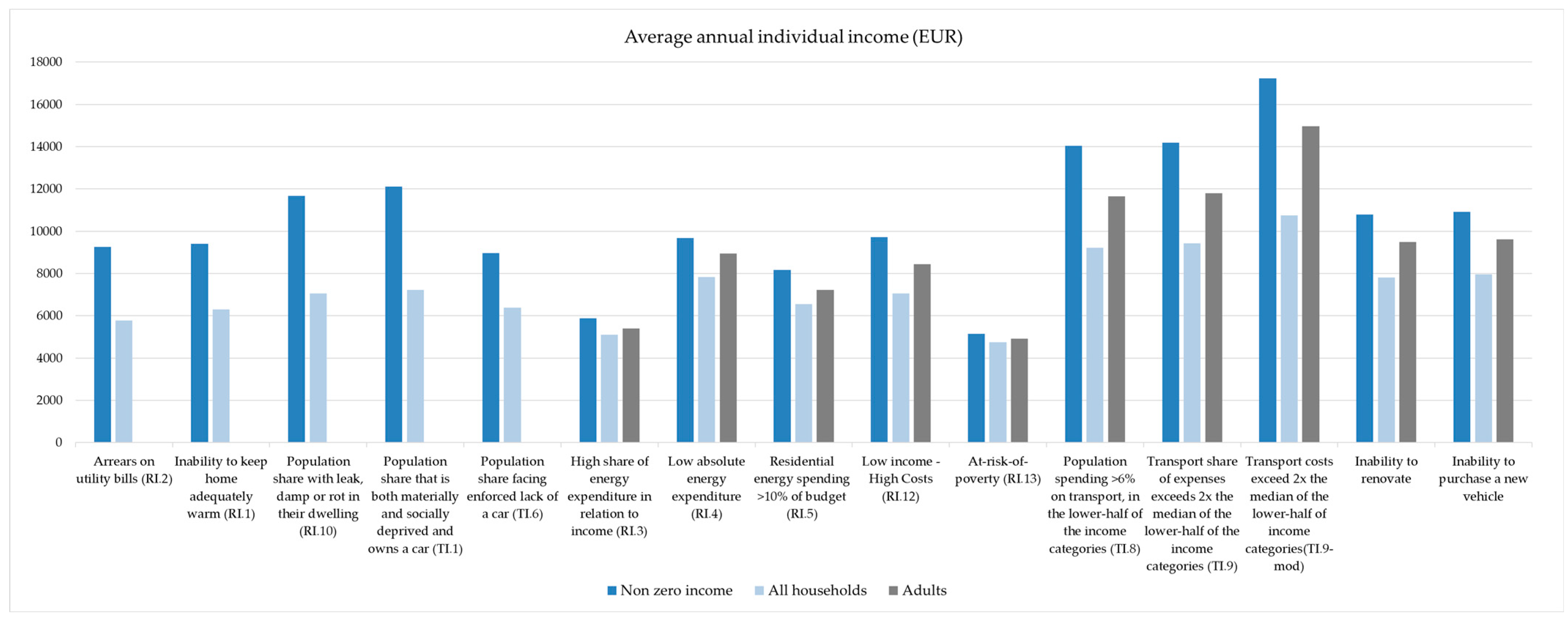
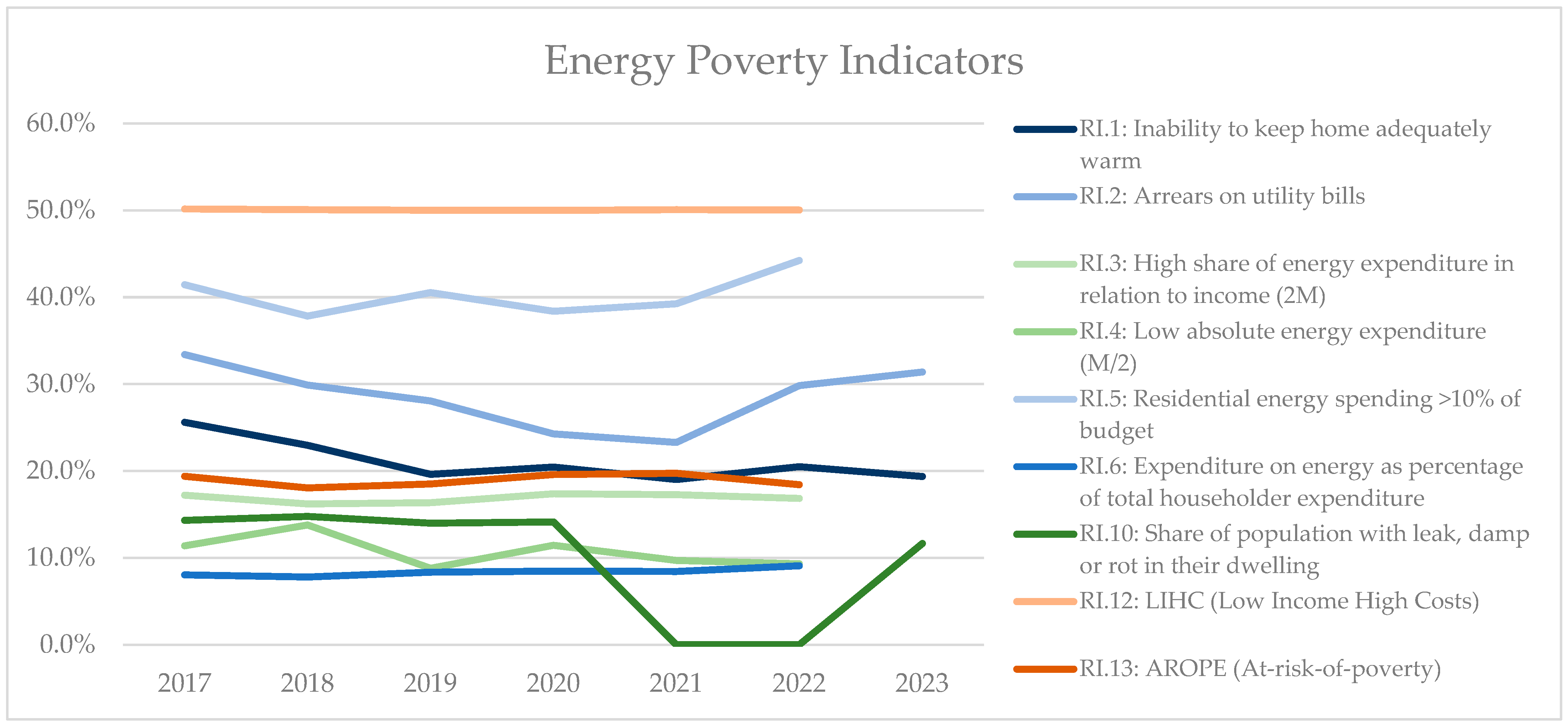
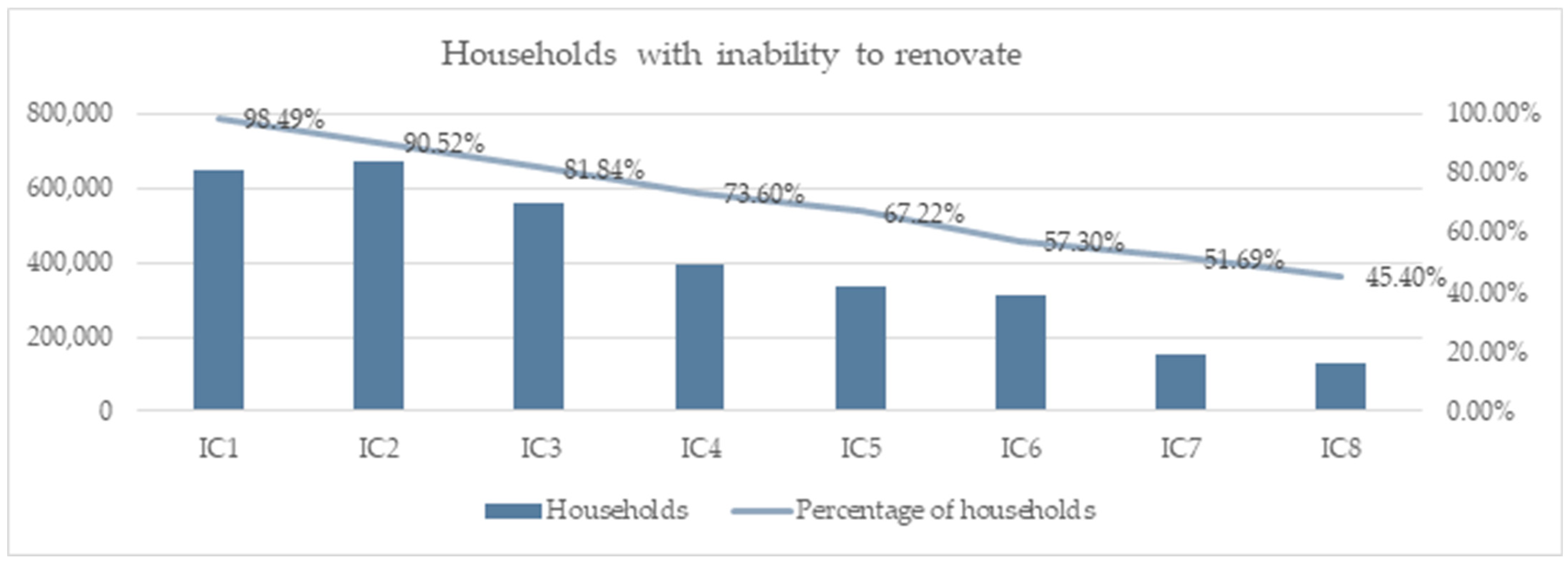

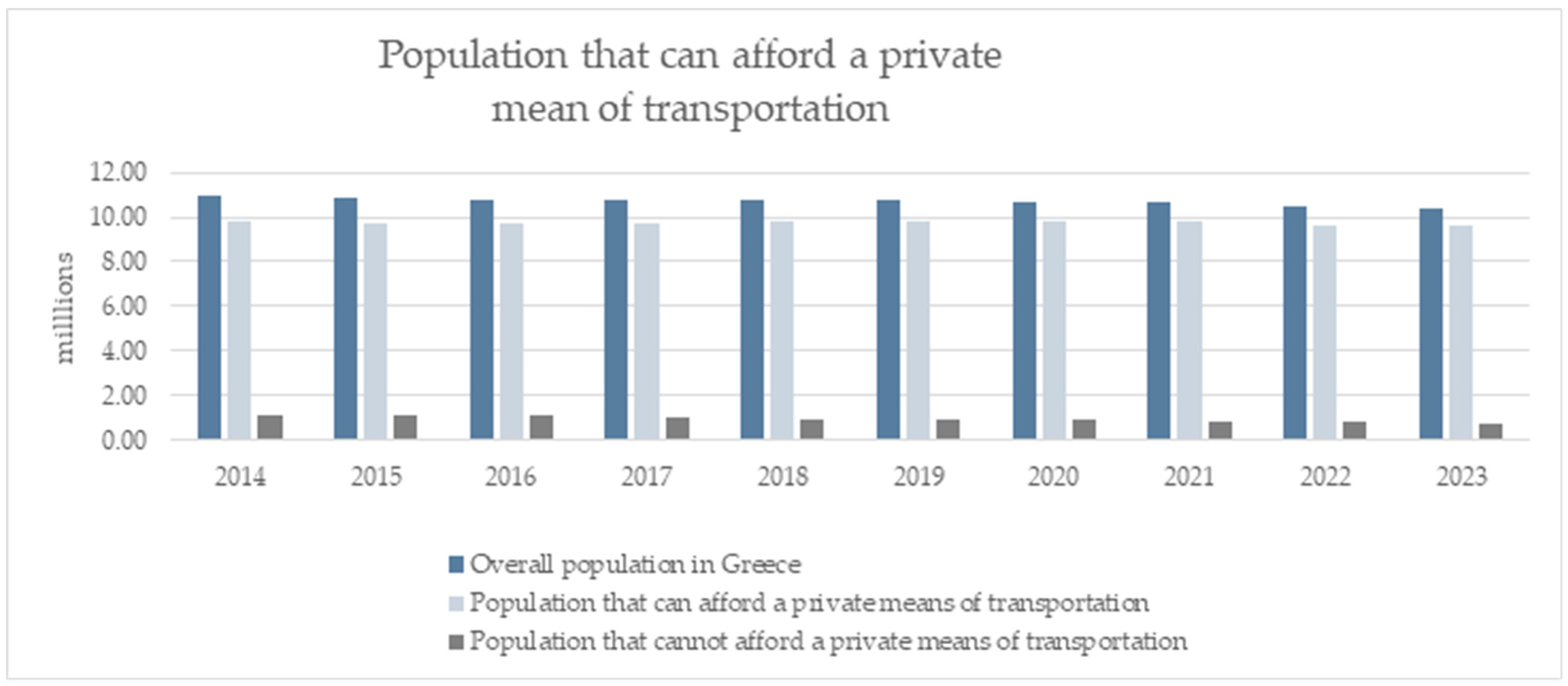
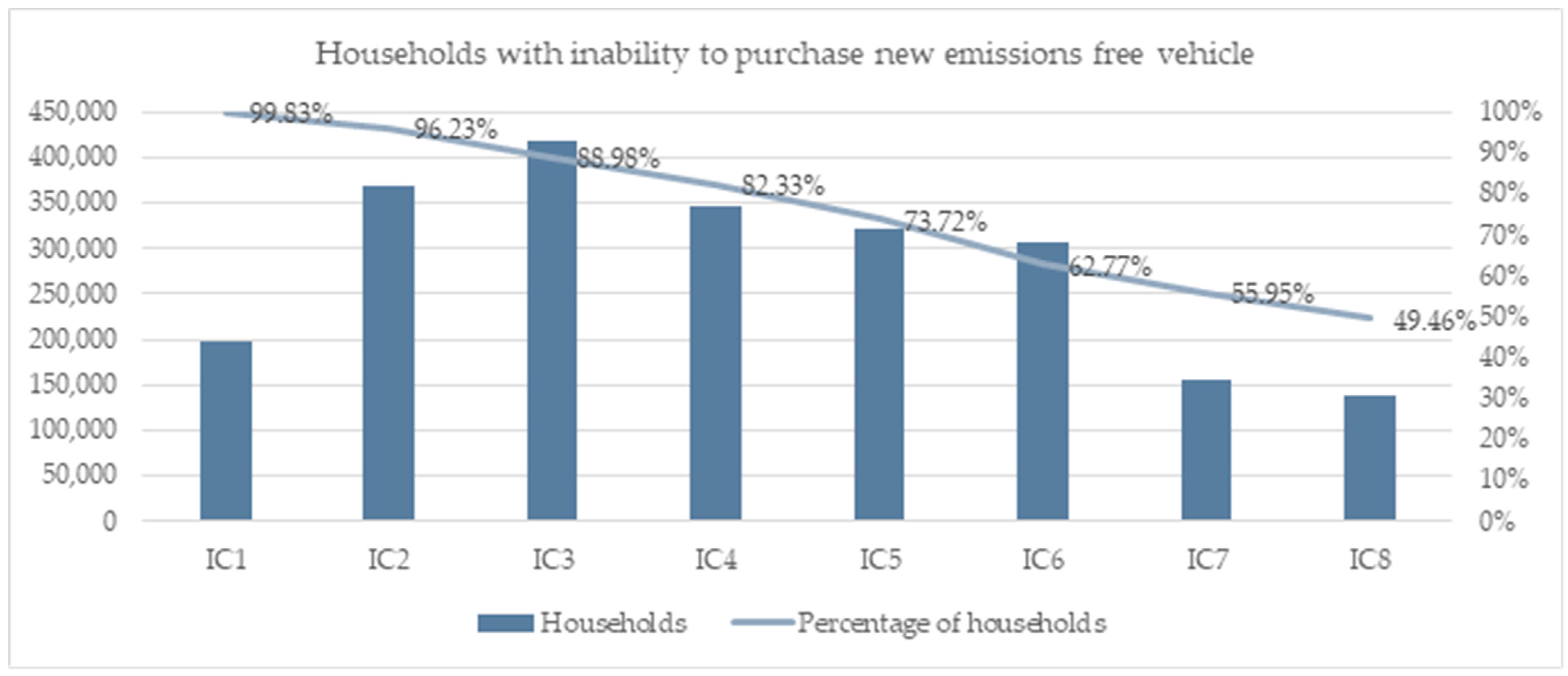
| Type | Indicators | Income Threshold | |
|---|---|---|---|
| Non-Zero Declared Income | All Household Members | ||
| Household vulnerability | In1—Inability to renovate | 10,782 | 7811 |
| Transport vulnerability | In2—Inability to purchase new zero-emission vehicle | 10,917 | 7950 |
| Household Composition | Total | <EUR 750 | <EUR 1100 | <EUR 1450 | <EUR 1800 | <EUR 2200 | <EUR 2800 | ≤EUR 3500 | ≥EUR 3501 |
|---|---|---|---|---|---|---|---|---|---|
| Single person below 65 years old | 704,697 | 198,380 | 202,301 | 134,676 | 85,375 | 21,840 | 35,799 | 17,074 | 9251 |
| Single person 65 years old and above | 673,523 | 284,559 | 188,584 | 112,143 | 53,133 | 15,819 | 14,788 | 2839 | 1659 |
| Single couple | 953,256 | 81,873 | 163,520 | 189,367 | 140,566 | 137,984 | 130,765 | 63,801 | 45,380 |
| Couple with 1 child above 16 years old | 312,050 | 7139 | 39,765 | 48,549 | 43,980 | 59,177 | 55,484 | 24,925 | 33,030 |
| Couple with 1 child up to 16 years old | 262,014 | 10,922 | 21,634 | 29,902 | 40,878 | 49,332 | 57,201 | 18,659 | 33,486 |
| Couple with 3 children and more above 16 years old | 100,349 | 2083 | 8896 | 18,072 | 13,158 | 13,114 | 19,342 | 14,062 | 11,622 |
| Single parent with 1 child or more up to 16 years old | 47,501 | 13,992 | 13,113 | 10,139 | 4347 | 1658 | 2799 | 1453 | 0 |
| Couple or single parent with children above 16 years old | 740,346 | 28,729 | 55,889 | 74,802 | 96,991 | 126,025 | 150,974 | 103,976 | 102,959 |
| Other type of household | 463,298 | 32,625 | 45,819 | 66,304 | 62,104 | 74,225 | 82,849 | 51,471 | 47,902 |
| Households with Non-Zero Income | |||
|---|---|---|---|
| Type | Indicators | Nr Households and % Total Households | Nr of Households Under ETS2 and % of Total Households |
| Energy-poor households | 859,843 (20.2%) | x | |
| Vulnerable households (4 income categories) | Inability to renovate | 1,617,828 (38%) | 826,826 (19.4%) |
| Transport-poor households | 1,416,964 (33.3%) | x | |
| Vulnerable transport users (4 income categories) | Inability to purchase new car | 1,820,498 (42.8%) | 965,574 (22.7%) |
| <EUR 750 | <EUR 1100 | <EUR 1450 | <EUR 1800 | |
|---|---|---|---|---|
| Vulnerable households ETS2 | 290,221 | 179,865 | 237,918 | 118,821 |
| % | 44.0% | 53.6% | 55.7% | 60.9% |
| Vulnerable transport ETS2 | 195,994 | 172,631 | 290,322 | 306,626 |
| % | 29.7% | 51.5% | 68% | 77.1% |
Disclaimer/Publisher’s Note: The statements, opinions and data contained in all publications are solely those of the individual author(s) and contributor(s) and not of MDPI and/or the editor(s). MDPI and/or the editor(s) disclaim responsibility for any injury to people or property resulting from any ideas, methods, instructions or products referred to in the content. |
© 2025 by the authors. Licensee MDPI, Basel, Switzerland. This article is an open access article distributed under the terms and conditions of the Creative Commons Attribution (CC BY) license (https://creativecommons.org/licenses/by/4.0/).
Share and Cite
Oikonomou, V.; Livraghi, S.; Karalaiou, K.; Rogulj, I.; Spyridakos, S.; Tourkolias, C. How to Distinguish Income Indicators of Energy and Transport Vulnerability—A Case Study of Greece. Sustainability 2025, 17, 4275. https://doi.org/10.3390/su17104275
Oikonomou V, Livraghi S, Karalaiou K, Rogulj I, Spyridakos S, Tourkolias C. How to Distinguish Income Indicators of Energy and Transport Vulnerability—A Case Study of Greece. Sustainability. 2025; 17(10):4275. https://doi.org/10.3390/su17104275
Chicago/Turabian StyleOikonomou, Vlasios, Samuele Livraghi, Konstantina Karalaiou, Ivana Rogulj, Stavros Spyridakos, and Christos Tourkolias. 2025. "How to Distinguish Income Indicators of Energy and Transport Vulnerability—A Case Study of Greece" Sustainability 17, no. 10: 4275. https://doi.org/10.3390/su17104275
APA StyleOikonomou, V., Livraghi, S., Karalaiou, K., Rogulj, I., Spyridakos, S., & Tourkolias, C. (2025). How to Distinguish Income Indicators of Energy and Transport Vulnerability—A Case Study of Greece. Sustainability, 17(10), 4275. https://doi.org/10.3390/su17104275










